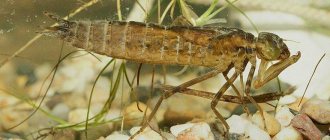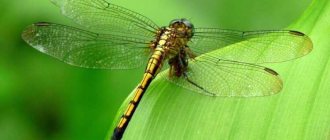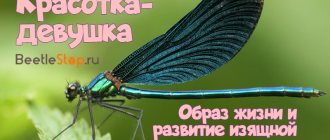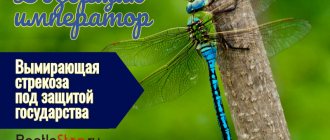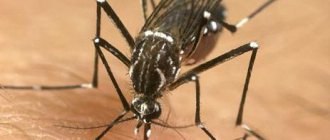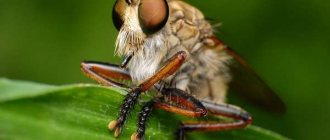- Wild animals
- >>
- Insects
The dragonfly is an arthropod insect with six legs, belonging to the subclass of winged insects, the order of dragonflies. The order of dragonflies currently includes more than 6,650 species of these insects. Dragonflies are fairly large predatory insects that have a movable head, large eyes, a long and slender abdomen and four transparent wings. They are found all over the world, with the exception of cold Antarctica.
Origin of the species
Dragonflies are an ancient group of arthropods. The first dragonflies lived on the planet back in the Carboniferous period during the Paleozoic era. The origin is related to the giant dragonfly-like insects Meganeura. Those, in turn, were large arthropods with a wingspan of up to 0.66 meters. They are considered the largest arthropods of that time. Subsequently, it was they who became the descendants of Kennedyina, Ditaxineurina, living already in the Triassic period of the Mesozoic. These arthropods were also distinguished by their large size, with a span of up to 90 mm. When the animals rested, the wings were hidden under the abdomen.
Meganeura
In those days, insects had a well-developed trapping basket. They used it to grab victims. The next descendants of Meganeura living in the Jurassic period are Lestomorpha, Libellulomorpha, the larvae of which are capable of developing in water. Their aircraft has changed significantly, becoming more advanced. The descendants of meganeurinids gradually settled throughout the planet.
At this time, the descendants of the superfamily Calopterygoidea changed dramatically. Their wings became narrower and evened out in size. The Cretaceous era carried away many suborders of insects, and in the Cenozoic era modern suborders of dragonflies can be seen. In the Neocene, dragonflies ceased to differ from modern ones.
From the depths of millennia
Three hundred million years ago there were no birds on Earth and giant dragonflies reigned in the air. One of them was Meganeura. Its wingspan reached 70 cm, like a large modern pigeon. Meganeura hunted other insects, which were also quite large. Today, the wingspan of the largest dragonfly living in South America barely exceeds 19 cm.
The ancient dragonfly Meganeura was the size of a large modern bird
Description, appearance and features
These insects are easy to distinguish from other arthropods with the naked eye. At the same time, the color of animals can vary dramatically. The most expressive parts of the insect's body are:
- Large head with expressive eyes.
- The body is brightly colored, sometimes shiny.
- Chest part.
- Transparent wings of various shades.
Dragonfly: appearance
Depending on the species, animals come in different sizes. The smallest dragonflies are considered to be up to 1.5 cm long. The largest representatives grow up to 10 cm. The large head can rotate 180 degrees. Large eyes consist of thousands of ommatidia, whose number can vary from 10,000 to 27.5 thousand.
It has been proven that the lower ommathia reproduce only colors, while the upper ones determine the shapes of objects. This feature allows dragonflies to perfectly navigate in flight and catch prey. On the crown of dragonflies there is a small swelling on which three additional eyes are located. Dragonflies also have awl-shaped antennae, they are short and consist of approximately four to seven segments.
Dragonfly eyes
Interesting fact : dragonfly eyes have a complex structure.
They consist of 30 thousand ommatii, capable of instantly orienting themselves in space. Powerful jaw apparatus formed by unpaired lips. In this case, the lower lip consists of three blades covering powerful jaws. The upper lip, in the form of a small plate stretched across, covers the upper jaw. The insect is able to catch and chew food during flight due to the difference in size of the upper and lower lips.
Interesting fact : dragonflies hunt other insects and avoid collisions thanks to a viewing angle of almost 360 degrees.
The thoracic part has three sections: anterior, middle, posterior, with a pair of limbs on each. The last two sections also contain the wings of the animal. The anterior section is separated from the middle, which together with the posterior section are fused together, forming a synthorax, which is perceived as a chest.
Structure of a dragonfly
The chest is flattened on the sides, and the dorsum is slightly pushed back. The middle part of the chest is higher than the back, so the wings are intertwined behind the legs. The front part of the backrest is divided into three sections. There is a dent on the middle one. The segments on which the wings grow are hypertrophied pleurites.
Interesting fact : dragonflies are resilient. Red tramps are record holders for migration. They cover enormous distances during flights - more than 6.5 thousand km.
The wings of dragonflies are practically colorless and consist of a pair of layers of chitin formed by a venation system. The veins are superimposed on each other in such a way that they appear to be a single network. The system is complex and dense, each order of dragonflies has a unique network of veins on their wings.
Interesting: Which people are most attracted to mosquitoes? Reasons, photos and videos
Dragonfly wings
The abdomen of dragonflies is round and elongated. Some species have a flat abdomen. In all species, the abdomen is the largest part of the body. The abdomen is divided into 10 segments. On the sides of the abdomen you can see pleural membranes, which allow the insect to bend.
On each segment, in addition to the last two, there are sigmas. At the tip of the abdomen are anal appendages, the number of which varies between females and males. Females have two, and males have three to four. The genitalia of females are located at the end of the abdomen, while in males the organ of compilation is located on the second abdominal segment. The opening for the release of sperm in males is located on the tenth abdominal segment. Insects have strong and well-formed limbs, consisting of the femur, pelvis, tibia and leg parts with paws. Each leg has spines.
Arrows
Arrows are not as spectacular as beauties, but just as graceful dragonflies. The photo of the graceful arrow, posted below, confirms this fact.
Shooters lead the same lifestyle as beauties, except that they choose more modest prey.
And it is not surprising, because the body length of the graceful arrow is only 3.5 cm, while the wingspan is 4.5 cm. The male has an elongated blue chest with a longitudinal black stripe and a black abdomen, as if intercepted by thin blue rings. The wings are narrow and transparent. Some females have a similar coloration, others are rather inexpressively colored and have neither stripes nor rings.
Arrows fly slowly and rarely leave their homes. Their larvae live and hunt in the stems and roots of aquatic plants. Distinguishing one species from another within this family is not an easy task. But it is impossible to confuse them with another family of arrows.
How to distinguish between male and female dragonflies?
Male and female dragonfly
Insects are characterized by sexual dimorphism. These are external differences between males and females, which are clearly noticeable especially in dragonflies. Dimorphism is important for dragonfly reproductive behavior. Surprisingly, the color of insects changes throughout life , the final establishment of color is noted at sexual maturity.
There are different types of sexual dimorphism in dragonflies. Some species are distinguished by large females and small males, while for others the opposite is true. Insect families also show certain trends in dimorphism. The beauties are distinguished by large males, and the shooters are distinguished by large females. The color of individuals is considered an important sign of sexual dimorphism. The pattern on the wings is also a sign of gender.
Sometimes insects exhibit polymorphism, that is, the presence of certain forms of one species that differ in color. In such cases, color is not associated with dimorphism.
Spotted inhabitants of America
The eight-spotted dragonfly lives in North America. It received this name because it has two black spots on each wing. And since the dragonfly has four wings, there are eight spots in total. The insect also has white spots. They are usually present in males, less often in females. You can meet these beauties from April to October.
This is what the American wings look like
Kelitemys dragonfly is native to America
Habitat – where does the dragonfly live?
Dragonflies are distributed throughout the world. The only place where dragonflies cannot be found is Antarctica. Most species are found in the Indo-Malayan region. There are approximately 1,664 species of animals found there. There are 1,640 species common in the neotropics, 889 in the Afrotropics, and 870 species in Australia and the region. Temperate areas are home to fewer species. This is because insects prefer warm, moist conditions.
Eggs are laid in water reservoirs and rivers. Depending on the variety, they are particularly sensitive to the choice of breeding site. Dragonflies Pseudostigmatinae prefer small water reservoirs, while other species can only breed in rivers or large lakes. The larvae are constantly in the water and can stay there for up to two years. Individuals that have learned to fly gradually fly away from their place of birth over long distances, migrating.
Selection of reservoirs and migration
When choosing a place for their offspring, dragonflies tend to show incredible plasticity. It can be said that almost all bodies of water, from rivers, lakes and streams to ditches, flooded hollows and depressions in the soil, are a completely acceptable habitat for larvae.
However, some species are more specialized and adapted only to certain conditions. There are nymphs that require high oxygen levels and require running water. Many tropical larvae, on the contrary, are adapted only to small bodies of standing water. A rather curious feature is the fact that in the cleanest lake on earth - Baikal, dragonflies are completely absent.
Moving over long distances is inherent in many insects. Dragonflies are no exception, capable of migrating over distances of several thousand kilometers , flying across entire oceans and mountain ranges. This phenomenon is adaptive in nature; insects fly away from an unfavorable environment in search of a more suitable home.
To read: How to get rid of ants in the garden forever: effective methods
Migration is usually carried out by scattered insects, but sometimes there are cases when dragonflies gather in huge flocks. For example, in the early 90s of the last century, a gigantic migration was recorded, numbering about 5 billion individuals, the total mass of which amounted to thousands of tons.
Habitat
Dragonfly habitat
Insects prefer warm zones, and spread in those areas where negative temperatures are not maintained for more than three months a year. The lifestyle of animals is amphibiotic, that is, the offspring are raised in water, and adults live in the ground-air environment.
Dragonflies are fast and easy to maneuver. The air is considered their home. Having occupied certain territories, dragonflies will defend them from enemies to the last, even from their relatives.
Lover of clean water
The flat-bellied dragonfly is so named due to its flattened and wide abdomen. By striking the end of her abdomen against the surface of the water, the female lays eggs. For this purpose, she prefers reservoirs with stagnant or low-flowing water. For the flat dragonfly, water purity is very important. And since the number of suitable places for its habitat has been rapidly decreasing in recent years, the flat dragonfly is listed in the Red Book.
"Clean" flat-bellied dragonfly
How long do dragonflies live?
Insects live for several months. Moreover, the entire development of dragonflies takes more than one year. The larvae that hatch under water live there from several months to four years. They evolve, hunt and hide from enemies. Gradually, dragonflies molt and grow, learning to fly. Adults leave water bodies and begin migration.
Dragonflies are special insects. They do not require pupae or cocoons to develop into adults. After emerging, the adult dragonfly dries out from the water for some time and begins its flight. A few hours after growing up, dragonflies begin hunting winged insects, gradually adapting to new conditions. At this stage of development, the insect is greatly influenced by the surrounding temperature and climate. In warm conditions without precipitation, dragonflies live up to six months, but in cold conditions they survive for several weeks.
Interesting: Bee: description, reproduction, lifestyle, habitat, nutrition, enemies, how honey is made, interesting facts
What does a dragonfly eat?
Dragonfly with prey
Dragonflies are predators, so they feed on most airborne insects. Their diet mainly consists of midges, mosquitoes, various flies, and arthropods. In the larval stage they eat small fish or their own kind.
Subspecies are divided according to hunting method:
- Free hunters fly high. They have strong, developed wings that allow them to maneuver on the upper tiers. Sometimes they hunt in a flock, but most often they hunt completely alone, flying at a distance of two to nine meters .
- Free flying, hunting in the territory of the middle tier. They do not fly over the two-meter high . They constantly look for food, sometimes resting on plants.
- Lying in wait - they hunt from ambush, waiting for prey.
- Dragonflies also live in the lower tier. They hunt in grass thickets, catching insects on plants. They feed while sitting on the grass, not in flight.
Nutrition
Dragonflies feed on a wide variety of insects. Their diet also includes blood-sucking animals: midges, mosquitoes, horseflies. The body shape of these creatures, which helps them fly beautifully, also provides them with significant service during hunting.
Dragonflies tend to attack their victims from below, overtaking them in the air. There is an explanation for this, because against the background of the sky, the visual organs of these predators, which actively react to ultraviolet and blue colors, are able to perceive objects best.
These insects are naturally endowed with a powerful mouth and serrated jaws, which helps them deal with prey. And its capture is facilitated by special claws, hard hairs on the legs and short antennae.
Dragonflies can eat weak members of their species
In an effort to get food for itself, a dragonfly is capable of engaging in single combat with an opponent that is larger than it. These creatures are very voracious, which brings considerable benefit by exterminating mosquitoes, flies and harmful insects.
They start hunting at dawn, and as soon as the sun sets, they settle down to sleep on the leaves of plants.
Features of character and lifestyle
Dragonfly
In Russia, dragonflies are found from mid-spring to mid-autumn. In warm regions, insects are found throughout the year. Insects are diurnal, being more active on warm sunny days.
In the mornings, dragonflies bask in the sun, resting on stones, grass or trees. At noon, they assume a “reflection” position, reflecting the sun’s rays with the tip of their abdomen. Thus, the animal does not overheat. Hunting takes place in the evenings and mornings. The species is more active during dawn. At night, dragonflies rest alone in the thickets.
Flying yoke
Although the large rocker dragonfly is not the largest in the world, it is not called large for nothing. Its length reaches 73 mm. It is not difficult to meet such a large dragonfly - from May to September it flies around its hunting grounds. And the rocker has a lot of them, because they live throughout Europe, in Transcaucasia, right up to Lake Baikal, in Siberia and Central Asia. Truly an omnipresent rocker!
The body shape of this insect really resembles a rocker
Social structure and reproduction
Life cycle of a dragonfly
Animals experience three processes of transformation: egg-larvae-imago, that is, adults. Dragonflies lay eggs several times a year. Mating occurs on the fly, males perform mating dances, showing various things in the air. One clutch contains up to 500 eggs. Only a few survive without being killed by fish or birds.
The larvae become adults only after a year, sometimes the process drags on for several years. The size of the new larvae is approximately 1 mm, molting begins almost immediately, they feed on their own and hunt underwater.
Fun fact : Certain species lay their eggs in salt water. Dragonflies are exceptional insects capable of living in the ocean.
Predator or herbivore?
The dragonfly is a predatory insect, and an active one at that; it hunts directly in the air, catching insects. In order to make it clearer what a dragonfly eats in nature, you will need to carefully consider its structure, which directly indicates the type of nutrition of this insect.
- The dragonfly's eye has a faceted structure, and its thin neck allows it to move its head - this improves visibility during the hunt and allows it to detect and track potential prey. The viewing radius reaches eight meters.
- The strong jaw is designed for cutting up caught prey; a dragonfly can gnaw and crush even the hardest chitin.
- To hold large insects, the dragonfly has tenacious limbs, and is able to catch very small animals immediately with its mouth in flight.
- The elegant and graceful body of the dragonfly allows it to maneuver beautifully and effectively in the air; it plots its flight path in such a way as to increase the efficiency of its hunting. It is difficult for even such dexterous insects as flies and midges to fly away from a dragonfly - it is a very fast predator.
Thus, the answer to the question of what dragonflies eat is becoming more and more obvious - it is a rather aggressive insect that hunts smaller individuals.
Types of dragonflies
These insects can be found all over the planet, so they are very diverse in appearance and structure. Some species of dragonflies are studied only from finds in a particular area, and some have become known thanks to single specimens. A significant part of the species has not yet been studied by researchers. In 2013, there were 6,650 species of dragonflies in the world, along with 608 fossils. Every year the number increases by several dozen. Over two years of research, the number of living species increased to 5,899.
Graceful arrow
Graceful arrow - dragonfly
They live on the European part of the continent. Small in size - up to 3.5 cm and with a thin elongated abdominal part. The wings are transparent, the limbs and body are black with a characteristic pattern of blue, black or green-yellow shades.
Beauty girl - dragonfly
Beauty girl - dragonfly.
Male (right) and female Relatively large insects, up to 50 mm long. Males are bluish or metallic in color, females have smoky transparent veiny wings. They are most often found in Asia, less often in southern Siberia.
Interesting fact : dragonflies tear off the wings of their victims, making it impossible for them to escape. At the same time, dragonflies are not capable of harming people due to the fact that they cannot bite through the skin.
Lyutki
Dragonfly from the family: Lutki
Lutki dull - common in the European part of Russia. They mainly settle in shallow waters and have a metallic greenish coloration. Can be of various colors and types.
Fun fact : Dragonflies are excellent fliers. Only a few insects on the planet can compete with dragonflies in the beauty of flight. Two pairs of wings are designed so that they can move independently of the others. Dragonflies can suddenly change direction of flight within a fraction of a second.
Dedka ordinary
The common damsel is a dragonfly, a male
dragonfly is of medium size - no more than 50 mm. With large green eyes and a chest painted with black oblique stripes. The chest is yellow, the abdominal part is black with small yellow spots on the sides. Distributed in Central Asia and the South Caucasus.
Interesting fact : dragonflies can live underwater for two years. The insects lay their eggs underwater, and the hatched offspring can spend up to two years there. They adapt to underwater life, learn to hunt and hide from enemies. Dragonflies can also feed on the larvae of their own kind.
Flatbellies
Flat-bellied dragonflies
Flat-bellied dragonflies are a fairly common family of dragonflies of various colors. Most often, dragonflies are brownish-yellow with green or blue stripes, sometimes with reddish patterns.
Interesting fact : There are dragonfly sanctuaries all over the world. Since human activity has a detrimental effect on insect populations, protected areas have been designated. The first such reserve opened in Britain in 2009.
What kind of wings do dragonflies have?
Dragonflies are either homoptera or heteroptera. Homoptera dragonflies include lyutki, beauties, arrows and others. These are small insects with wings of the same shape and size, folded behind their backs when at rest. Heteropterous dragonflies, which include damseflies, rockers and watchers, are larger than homoptera. Due to the fact that the wings of these insects are unequal, during flight they are forced to flap faster with the back pair of wings than the front ones - this is the only way to fly smoothly. And at rest, the wings of a dragonfly with different wings are always spread out, because it cannot fold them.
Beauty girl - dragonfly
Dedka common - heteroptera dragonfly
Population and species status
Blue Dragonfly
Dragonflies are distributed throughout the globe. As of 2013, there were approximately 6,650 animal species on the planet. At the moment, the figures have increased significantly. Researchers are constantly finding new species. However, at the moment, some species of dragonflies may disappear forever. This occurs due to constant human pollution of the environment.
Interesting: Why are the waffles checkered?
At the end of 2022, there were more than three hundred species at risk of extinction. One species, Megalagrion jugorum, is considered permanently extinct. Approximately 10% of all animal species are threatened with extinction. Insects are important for determining the condition of natural bodies of water. They hunt pests and react strongly to changes in water quality. To preserve species, you need to take care of nature.
Lifestyle
Dragonflies are diurnal predators and are active in warm, sunny weather. Night time and inclement weather are experienced in shelter. In the morning hours, adults gain energy by basking in the sun. They land on tree bark, branches, and grass stems. In hot weather, they point the tip of their abdomen upward, reducing the area of sun exposure. Adults have excellent vision. They notice prey at a great distance and successfully attack.
Insects have no food preferences; they hunt any objects of suitable size. Varied-winged predators easily maneuver and dive, can make high-speed flights and move a considerable distance from the place of birth. Mass migration of the common dragonfly is observed in July-September. The emergence of adults after molting occurs gradually, so individual individuals can be found even in October.
Despite its reputation as a ruthless predator, the dragonfly itself often becomes prey. It is hunted by birds, reptiles, and mammals. Insects that land on the water are attacked by fish. Cannibalism flourishes among representatives of the order Odonata; large individuals catch and eat smaller ones. Swimming beetles and water bugs pose a danger to the larvae. How long does the common dragonfly live? This species spends several months at the adult stage. The larva develops for about 1 year.
Habitat
The common dragonfly is a transpalearctic species. Insects live in large numbers in Europe, Central Asia, Siberia, the Far East and northern Africa. They settle near lakes, swamps, and reclamation canals. They prefer ponds abundantly overgrown with vegetation.
Dragonfly protection
Dragonfly
Animals occupy an important place in the functioning of the ecosystem. They destroy pests and are considered food for birds and fish, as well as mammals and other insects. In addition, it is possible to determine the state of water in the region based on the state of dragonflies. Dragonflies begin to die out where water bodies are polluted.
Many species are under threat of complete extinction due to constant pollution of water bodies. The established society for the protection of these insects monitors population sizes.
The benefits and harms of dragonflies for humans
Dragonflies bring both harm and benefit. They eat harmful insects, for example, they eat the Tsetse fly, which is deadly to humans. In addition, they themselves are food for birds and some amphibians.
But the immoderate appetite of naiads and adult dragonflies leads to the fact that some insects disappear from the face of the earth altogether. And also the eating of fish fry by naiads leads to the disappearance of some species of fish.
Economic importance
Like many predators, dragonflies are useful and at the same time harmful to the economy. Adult insects destroy pests, but the larvae often eat the necessary fish species in lakes. The larvae are also considered carriers of avian prostagonymosis, as they are hosts for parasites. In such cases, domestic poultry such as chickens, turkeys and geese are affected. Trematodes are often found in wild animals. The excrement of sick birds that falls into the water is eaten by mollusks, where miracidia begin to develop. They gradually turn into sporocysts and redia, after which they emerge from the mollusks and again end up in dragonfly larvae. The process is repeated again and again as the birds destroy the larvae.
